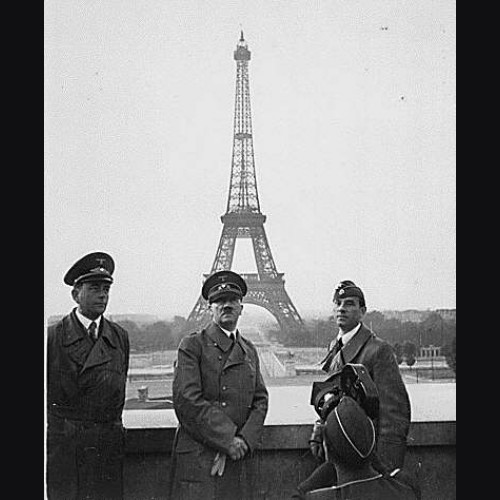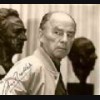B4. Arno Breker # 495
Arno Breker (July, 19, 1900 – February 13, 1991) was a German sculptor, best known for his public works in Nazi Germany, which were highly valued amongst the German hierarchy as accepted art. He was born in Elberfeld, now Wuppertal and died in Dusseldorf.
The son of a stone mason. He began to study architecture, along with stone-carving and anatomy, and at age 20 was accepted to the Düsseldorf Academy of Arts where concentrated on sculpture. He first visited Paris in 1924, shortly before finishing his studies. There he met with Jean Renoir, Pablo Picasso.In 1927 he moved to Paris, which he thereafter considered to be his home. He was quickly accepted by the art dealer Alfred Flechtheim. He also established close relationships with important figures in the art world.
He was awarded a prize in 1932 by the Prussian Ministry of Culture and returned to Germany in 1934. Breker was supported by many leaders in Nazi Germany including Adolf Hitler. He took commissions from the Nazi party from 1933-42 for taking part in various shows, one in Paris in 1942. He maintained relationships with noted figures such as Albert Speer and Hitler himself. A picture of the three men appears in front of Eiffel Tower just after the Nazi occupation of France. In 1936 he was commissioned to do two sculptures representing athletics for the 1936 Olympic games. He married Demetra Messala in 1937, the same year joining the Nazi party for further good graces from Hitler.
His works typified Nazi ideals with works such as Torchbearer, and his sculptures The Party and The Army held positions at the entrance of the Reich Chancellery. Breker was a professor of visual arts in Berlin, until the fall of the Third Reich. While nearly all of his sculptures survived WWII, more than 90% of his public work was destroyed by the allies after the war.
In 1948 Breker was designated as a "fellow traveler" of the Nazis and was fined. At this time he returned to Düsseldorf, which remained his base, with periods of residence in Paris. During this time he worked as an architect. However, he continued to receive commissions for sculptures, producing a number of works in his familiar classical style, working for businesses and individual patrons. He also produced many portrait sculptures. In 1970 he was commissioned by the king of Morocco to produce work for the United Nations Building in Casablanca the work was destroyed. Many other portrait works followed, including Anwar Sadat and. Breker's rehabilitation continued, culminating in plans for the creation of a Breker museum, funded by the Bodenstein family, who set aside the castle of Nörvenich, between Aachen and Cologne for the purpose. The Arno Breker Museum was inaugurated in 1985.
Breker's rehabilitation led to backlashes from anti-Nazi activists, including controversy in Paris when some of his works were exhibited at the in 1981. In the same year anti-Breker demonstrations accompanied an exhibition in Berlin. Breker's admirers insisted that he had never been a supporter of Nazi ideology (despite being a member of the Nazi Party), but had simply accepted their patronage.
Breker's last major work was a monumental sculpture of Alexander The Great intended to be located in Greece.
Pictured from left is Albert Speer, Adolf Hitler, and Arno Breker following the occupation of France.
Arno BrekerArno Breker (July, 19, 1900 – February 13, 1991) was a German sculptor, best known for his public works in Nazi Germany, which were highly valued amongst the German hierarchy as accepted art. He was born in Elberfeld, now Wuppertal and died in Dusseldorf.
The son of a stone mason. He began to study architecture, along with stone-carving and anatomy, and at age 20 was accepted to the Düsseldorf Academy of Arts where concentrated on sculpture. He first visited Paris in 1924, shortly before finishing his studies. There he met with Jean Renoir, Pablo Picasso.In 1927 he moved to Paris, which he thereafter considered to be his home. He was quickly accepted by the art dealer Alfred Flechtheim. He also established close relationships with important figures in the art world.
He was awarded a prize in 1932 by the Prussian Ministry of Culture and returned to Germany in 1934. Breker was supported by many leaders in Nazi Germany including Adolf Hitler. He took commissions from the Nazi party from 1933-42 for taking part in various shows, one in Paris in 1942. He maintained relationships with noted figures such as Albert Speer and Hitler himself. A picture of the three men appears in front of Eiffel Tower just after the Nazi occupation of France. In 1936 he was commissioned to do two sculptures representing athletics for the 1936 Olympic games. He married Demetra Messala in 1937, the same year joining the Nazi party for further good graces from Hitler.
His works typified Nazi ideals with works such as Torchbearer, and his sculptures The Party and The Army held positions at the entrance of the Reich Chancellery. Breker was a professor of visual arts in Berlin, until the fall of the Third Reich. While nearly all of his sculptures survived WWII, more than 90% of his public work was destroyed by the allies after the war.
In 1948 Breker was designated as a "fellow traveler" of the Nazis and was fined. At this time he returned to Düsseldorf, which remained his base, with periods of residence in Paris. During this time he worked as an architect. However, he continued to receive commissions for sculptures, producing a number of works in his familiar classical style, working for businesses and individual patrons. He also produced many portrait sculptures. In 1970 he was commissioned by the king of Morocco to produce work for the United Nations Building in Casablanca the work was destroyed. Many other portrait works followed, including Anwar Sadat and. Breker's rehabilitation continued, culminating in plans for the creation of a Breker museum, funded by the Bodenstein family, who set aside the castle of Nörvenich, between Aachen and Cologne for the purpose. The Arno Breker Museum was inaugurated in 1985.
Breker's rehabilitation led to backlashes from anti-Nazi activists, including controversy in Paris when some of his works were exhibited at the in 1981. In the same year anti-Breker demonstrations accompanied an exhibition in Berlin. Breker's admirers insisted that he had never been a supporter of Nazi ideology (despite being a member of the Nazi Party), but had simply accepted their patronage.
Breker's last major work was a monumental sculpture of Alexander The Great intended to be located in Greece.
Pictured from left is Albert Speer, Adolf Hitler, and Arno Breker following the occupation of France.
Arno Breker


